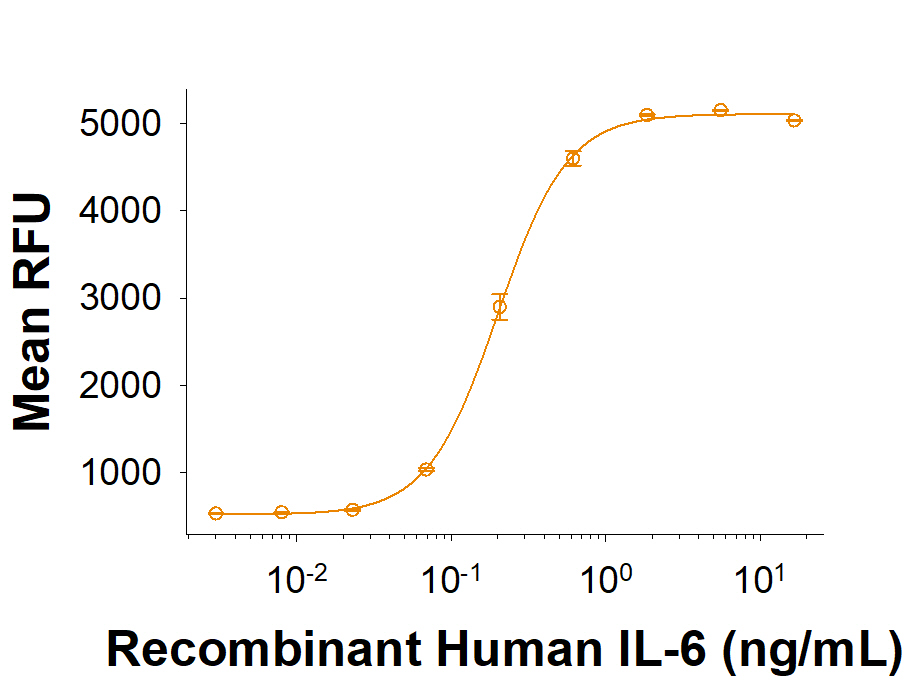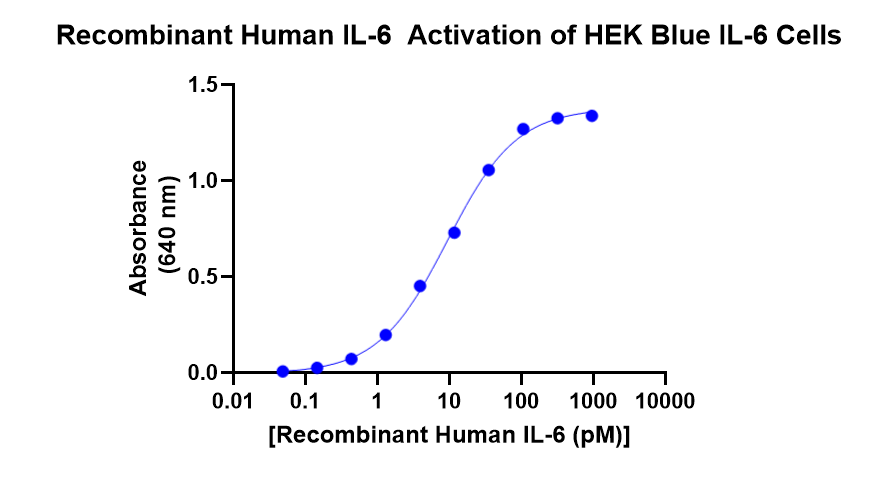Recombinant Human IL-6 (HEK293-expressed) Protein Summary
Product Specifications
Val30-Met212
Analysis
Product Datasheets
Carrier Free
CF stands for Carrier Free (CF). We typically add Bovine Serum Albumin (BSA) as a carrier protein to our recombinant proteins. Adding a carrier protein enhances protein stability, increases shelf-life, and allows the recombinant protein to be stored at a more dilute concentration. The carrier free version does not contain BSA.
In general, we advise purchasing the recombinant protein with BSA for use in cell or tissue culture, or as an ELISA standard. In contrast, the carrier free protein is recommended for applications, in which the presence of BSA could interfere.
7270-IL
| Formulation | Lyophilized from a 0.2 μm filtered solution in PBS with BSA as a carrier protein. |
| Reconstitution | Reconstitute at 100 μg/mL in PBS containing at least 0.1% human or bovine serum albumin. |
| Shipping | The product is shipped at ambient temperature. Upon receipt, store it immediately at the temperature recommended below. |
| Stability & Storage: | Use a manual defrost freezer and avoid repeated freeze-thaw cycles.
|
7270-IL/CF
| Formulation | Lyophilized from a 0.2 μm filtered solution in PBS. |
| Reconstitution | Reconstitute at 100 μg/mL in PBS. |
| Shipping | The product is shipped at ambient temperature. Upon receipt, store it immediately at the temperature recommended below. |
| Stability & Storage: | Use a manual defrost freezer and avoid repeated freeze-thaw cycles.
|
Scientific Data
 View Larger
View Larger
Measured in a cell proliferation assay using T1165.85.2.1 mouse plasmacytoma cells. The ED50 for this effect is 0.1-0.6 ng/mL.
Reconstitution Calculator
Background: IL-6
Interleukin-6 (IL-6) is a pleiotropic, alpha -helical, 22-28 kDa phosphorylated and variably glycosylated cytokine that plays important roles in the acute phase reaction, inflammation, hematopoiesis, bone metabolism, and cancer progression (1-5). Mature human IL-6 is 183 amino acids (aa) in length and shares 39% aa sequence identity with mouse and rat IL-6 (6). Alternative splicing generates several isoforms with internal deletions, some of which exhibit antagonistic properties (7-10). IL-6 induces signaling through a cell surface heterodimeric receptor complex composed of a ligand binding subunit (IL-6 R alpha) and a signal transducing subunit (gp130). IL-6 binds to IL-6 R alpha, triggering IL-6 R alpha association with gp130 and gp130 dimerization (11). gp130 is also a component of the receptors for CLC, CNTF, CT-1, IL-11, IL-27, LIF, and OSM (12). Soluble forms of IL-6 R alpha are generated by both alternative splicing and proteolytic cleavage (5). In a mechanism known as trans-signaling, complexes of soluble IL-6 and IL-6 R alpha elicit responses from gp130-expressing cells that lack cell surface IL-6 R alpha (5). Trans-signaling enables a wider range of cell types to respond to IL-6, as the expression of gp130 is ubiquitous, while that of IL-6 R alpha is predominantly restricted to hepatocytes, monocytes, and resting lymphocytes (2, 5). Soluble splice forms of gp130 block trans-signaling from IL-6/IL-6 R alpha but not from other cytokines that use gp130 as a co-receptor (5, 13). IL-6, along with TNF-alpha and IL-1, drives the acute inflammatory response and the transition from acute inflammation to either acquired immunity or chronic inflammatory disease (1-5). When dysregulated, it contributes to chronic inflammation in obesity, insulin resistance, inflammatory bowel disease, arthritis, sepsis, and atherosclerosis (1, 2, 5). IL-6 can also function as an anti-inflammatory molecule, as in skeletal muscle where it is secreted in response to exercise (2). In addition, it enhances hematopoietic stem cell proliferation and the differentiation of Th17 cells, memory B cells, and plasma cells (1, 14).
- Mansell, A. and B.J. Jenkins (2013) Cytokine Growth Factor Rev. 24:249.
- Schuett, H. et al. (2009) Thromb. Haemost. 102:215.
- Erta, M. et al. (2012) Int. J. Biol. Sci. 8:1254.
- Garbers, C. et al. (2012) Cytokine Growth Factor Rev. 23:85.
- Mihara, M. et al. (2012) Clin. Sci. (Lond.) 122:143.
- Hirano, T. et al. (1986) Nature 324:73.
- Kestler, D.P. et al. (1995) Blood 86:4559.
- Kestler, D.P. et al. (1999) Am. J. Hematol. 61:169.
- Bihl, M.P. et al. (2002) Am. J. Respir. Cell Mol. Biol. 27:48.
- Alberti, L. et al. (2005) Cancer Res. 65:2.
- Murakami, M. et al. (1993) Science 260:1808.
- Muller-Newen, G. (2003) Sci. STKE 2003:PE40.
- Mitsuyama, K. et al. (2006) Clin. Exp. Immunol. 143:125.
- Cerutti, A. et al. (1998) J. Immunol. 160:2145.
Citations for Recombinant Human IL-6 (HEK293-expressed) Protein
R&D Systems personnel manually curate a database that contains references using R&D Systems products. The data collected includes not only links to publications in PubMed, but also provides information about sample types, species, and experimental conditions.
7
Citations: Showing 1 - 7
Filter your results:
Filter by:
-
IRF1 Mediates Growth Arrest and the Induction of a Secretory Phenotype in Alveolar Epithelial Cells in Response to Inflammatory Cytokines IFN?/TNF?
Authors: Recchia Luciani, G;Barilli, A;Visigalli, R;Sala, R;Dall'Asta, V;Rotoli, BM;
International journal of molecular sciences
Species: Human hepegivirus
Sample Types: Whole Cells
Applications: Bioassay -
TGF-Beta Induces Activin A Production in Dermal Fibroblasts Derived from Patients with Fibrodysplasia Ossificans Progressiva
Authors: RD de Ruiter, LE Wisse, T Schoenmake, M Yaqub, G Sánchez-Du, EMW Eekhoff, D Micha
International Journal of Molecular Sciences, 2023-01-24;24(3):.
Species: Human
Sample Types: Whole Cells
Applications: Bioassay -
Kynurenine metabolites predict survival in pulmonary arterial hypertension: A role for IL-6/IL-6Ralpha
Authors: Z Cai, S Tian, T Klein, L Tu, LW Geenen, T Koudstaal, AE van den Bo, YB de Rijke, IKM Reiss, E Boersma, C van der Le, M Van Faasse, I Kema, DJ Duncker, KA Boomars, K Tran-Lundm, C Guignabert, D Merkus
Scientific Reports, 2022-07-19;12(1):12326.
Species: Human
Sample Types: Whole Cells
Applications: Bioassay -
GLI1 activates pro-fibrotic pathways in myelofibrosis fibrocytes
Authors: T Manshouri, I Veletic, P Li, CC Yin, SM Post, S Verstovsek, Z Estrov
Cell Death & Disease, 2022-05-20;13(5):481.
Species: Xenograft
Sample Types: Whole Cells
Applications: Bioassay -
Deletion of STAT3 from Foxd1 cell population protects mice from kidney fibrosis by inhibiting pericytes trans-differentiation and migration
Authors: AK Ajay, L Zhao, S Vig, M Fujiwara, S Thakurela, S Jadhav, A Cho, IJ Chiu, Y Ding, K Ramachandr, A Mithal, A Bhatt, P Chaluvadi, MK Gupta, SI Shah, VS Sabbisetti, AM Waaga-Gass, DA Frank, G Murugaiyan, JV Bonventre, LL Hsiao
Cell Reports, 2022-03-08;38(10):110473.
Species: Human
Sample Types: Whole Cells
Applications: Bioassay -
A novel antibody for the detection of alternatively spliced secreted KLOTHO isoform in human plasma
Authors: S Jadhav, S Tripathi, A Chandrekar, SS Waikar, LL Hsiao
PLoS ONE, 2021-01-22;16(1):e0245614.
Species: Human
Sample Types: Protein
Applications: ELISA Capture -
The inhibitory effect of TU-100 on hepatic stellate cell activation in the tumor microenvironment
Authors: Y Wada, K Tokuda, Y Morine, S Okikawa, S Yamashita, T Ikemoto, S Imura, Y Saito, S Yamada, M Shimada
Oncotarget, 2020-12-08;11(49):4593-4604.
Species: Human
Sample Types: Whole Cells
Applications: Cell Culture
FAQs
-
What are the differences between Recombinant Human IL-6 Protein (Catalog # 206-IL) and Recombinant Human IL-6 (HEK293-expressed) Protein (Catalog # 7270-IL)?
Recombinant Human IL-6 Protein (Catalog # 206-IL) is raised in E. coli. The Recombinant Human IL-6 (HEK293-expressed) Protein (Catalog # 7270-IL) is raised in HEK293. Because #7270-IL is raised in mammalian cells, it is expected to have post translational modifications that are absent in the E. coli-derived version (206-IL). The HEK293-derived #7270-IL exhibits greater activity than the E. coli-derived #206-IL in the same activity assay.
Reviews for Recombinant Human IL-6 (HEK293-expressed) Protein
Average Rating: 4.5 (Based on 2 Reviews)
Have you used Recombinant Human IL-6 (HEK293-expressed) Protein?
Submit a review and receive an Amazon gift card.
$25/€18/£15/$25CAN/¥75 Yuan/¥2500 Yen for a review with an image
$10/€7/£6/$10 CAD/¥70 Yuan/¥1110 Yen for a review without an image
Filter by:
Reason for Rating: Activation of HEK Blue Cells with EC50 of 0.2ng/ml as stated in datasheet.
HEK Blue IL-6 assay from Invivogen












